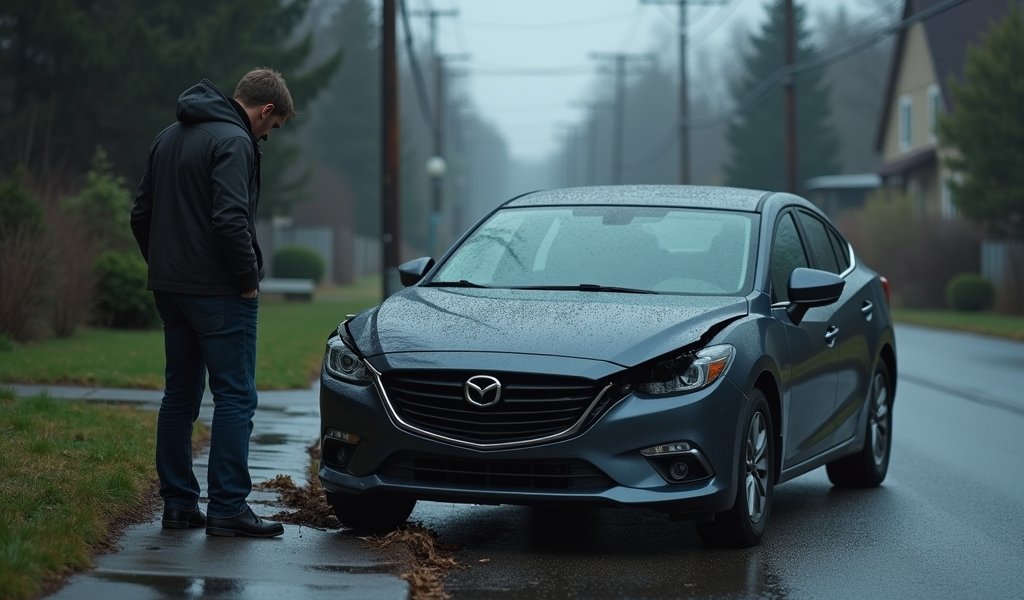Overview
This article provides five strategic fixes to manage car insurance after an accident: evaluating current coverage, shopping for new rates, utilizing accident forgiveness, taking defensive driving courses, and adjusting deductibles and coverage levels. It emphasizes that drivers can minimize premium increases through proactive steps rather than passively accepting rate hikes, potentially saving hundreds of dollars while maintaining appropriate protection.
Table of Contents
- Understanding Car Insurance After an Accident
- Fix 1: Evaluate Your Current Coverage
- Fix 2: Shop Around for New Rates
- Fix 3: Take Advantage of Accident Forgiveness
- Fix 4: Consider Defensive Driving Courses
- Fix 5: Adjust Your Deductibles and Coverage
- When to Consider Legal Assistance
- Conclusion
- Frequently Asked Questions
Understanding Car Insurance After an Accident
Getting into a car accident is stressful enough without having to worry about what happens to your insurance afterward. Trust me, I’ve seen the panic in countless drivers’ eyes when they realize their premiums might skyrocket. Car insurance after an accident often changes—sometimes dramatically—but it doesn’t have to be a financial disaster.
When that dreaded fender bender occurs, your insurance company typically sees you as a higher risk. It’s not personal; it’s just math. Statistics show that drivers who have been in one accident are more likely to be involved in another. According to the Insurance Information Institute, drivers can expect an average premium increase of 42% after making a claim for an accident they caused.
But here’s the thing—you’re not powerless in this situation. There are practical steps you can take to minimize the financial impact and even potentially improve your coverage in the process. Think of an accident as an opportunity to reassess your insurance needs rather than just a penalty.
Before we dive into specific solutions, it’s important to know what information to exchange after a wreck. Having the right details can make the claims process smoother and potentially affect how the incident impacts your insurance.
Now, let’s look at five proven fixes that can help you navigate car insurance after an accident. With the right approach, you can minimize rate increases and even find better coverage options.
Fix 1: Evaluate Your Current Coverage
After the dust settles from an accident, the first thing you should do is take a good, hard look at your existing policy. Many drivers I’ve worked with were paying for coverage they didn’t need or—worse—lacking protection in critical areas without realizing it.
Pull out your policy documents or log into your insurer’s online portal. Look specifically at these key components:
- Liability limits (both bodily injury and property damage)
- Collision coverage details
- Comprehensive coverage terms
- Uninsured/underinsured motorist coverage
- Personal injury protection (PIP) or medical payments coverage
- Deductible amounts
Do these coverage levels still make sense for your situation? For example, if you’re driving an older vehicle that’s lost significant value, you might be overpaying for collision coverage. Conversely, if your liability limits are too low, you could be dangerously exposed in the event of a serious accident.
Understanding what full coverage car insurance really means can help you make better decisions about your policy. Despite its name, “full coverage” doesn’t actually cover everything—it’s typically just a combination of liability, collision, and comprehensive coverage.
One client discovered she was paying for rental car coverage she didn’t need since she had access to a spare family vehicle. Another realized his deductible was so high that filing a claim for minor damage wasn’t worthwhile. These small adjustments can add up to significant savings that might offset some of that post-accident rate increase.
Remember, insurance isn’t just about meeting legal requirements—it’s about protecting yourself financially. An accident is a perfect reminder to make sure your protection matches your current needs.

Fix 2: Shop Around for New Rates
Loyalty doesn’t always pay when it comes to insurance. One of the most effective ways to deal with car insurance after an accident is to see what other companies might offer you. Different insurers use different formulas to calculate risk, and an accident that sends your premium through the roof with one company might barely register with another.
I’ve seen drivers save hundreds—sometimes even thousands—by switching carriers after an accident. The key is to compare car insurance quotes online from multiple providers. Make sure you’re comparing policies with equivalent coverage to get an accurate picture of potential savings.
When shopping around, be completely honest about your accident history. It might be tempting to “forget” to mention a recent fender bender, but insurance companies have access to your driving record and claims history through various databases. Misrepresentation could lead to a denied claim or cancelled policy down the road—a far worse outcome than a higher premium.
Here’s what to have ready when requesting quotes:
- Vehicle information (year, make, model, VIN)
- Details about your driving history, including the recent accident
- Your current coverage limits
- Information about all drivers in your household
- Your average annual mileage
Take advantage of quote comparison tools from independent sites like NerdWallet, which can show you rates from multiple insurers at once. Sometimes smaller, regional insurers offer better rates than the national brands, especially for drivers with recent accidents.
Don’t just focus on the premium—look at the company’s customer satisfaction ratings and claims handling reputation. Saving $200 a year won’t feel like a bargain if you’re dealing with a claims adjuster who’s impossible to reach after your next fender bender.
Fix 3: Take Advantage of Accident Forgiveness
If you’re kicking yourself for not having accident forgiveness before your recent collision, I understand. It’s one of those things many drivers don’t think about until they need it. However, it might not be too late to benefit from this feature, depending on your situation.
Accident forgiveness is an insurance policy add-on that prevents your rates from increasing after your first at-fault accident. Some companies offer it as a free benefit to long-term customers with clean driving records, while others charge a small additional premium for the protection.
If you already have accident forgiveness with your current insurer, make sure they’ve applied it to your recent accident. Sometimes this doesn’t happen automatically—you may need to specifically request it. Check your policy or call your agent to confirm.
If you don’t currently have this protection, consider these options:
- Some insurers might allow you to add accident forgiveness that would apply to your next accident, even if your rates have already increased from a recent one
- When shopping for a new policy, look specifically for companies that offer accident forgiveness to new customers
- Ask about “accident forgiveness with a waiting period” – some companies will add this feature but require a waiting period (often 6 months to a year of claim-free driving) before it becomes active
Companies like Allstate, Liberty Mutual, Progressive, and Nationwide all offer some form of accident forgiveness, though the specifics vary widely. According to research from the Insurance Information Institute, drivers with accident forgiveness typically pay 3-9% more for this feature—but that’s far less than the 20-40% increase many face after an at-fault accident.
Keep in mind that accident forgiveness doesn’t erase the accident from your driving record—it just prevents your current insurer from raising your rates because of it. If you switch companies later, the new insurer will still see the accident and may price your policy accordingly.
Fix 4: Consider Defensive Driving Courses
Sometimes the best way to overcome the financial impact of an accident is to demonstrate that you’re actively becoming a safer driver. Defensive driving courses are a practical way to do exactly that—while potentially earning a discount on your premiums.
Many insurance companies offer rate reductions of 5-15% for drivers who complete approved defensive driving or accident prevention courses. These courses typically cost between $25 and $100 and can often be completed online in just a few hours. The premium discount usually lasts for three years, making this investment well worth your time.
Beyond the insurance benefits, these courses can genuinely make you a better driver. They teach valuable skills like:
- Accident avoidance techniques
- How to handle skids and emergency situations
- The effects of medication, fatigue, and alcohol on driving ability
- Proper following distances and space management
- Recognizing and adjusting for hazardous driving conditions
Before signing up, check with your insurance company to confirm which courses they recognize for discounts. The National Safety Council, AAA, and AARP all offer well-respected defensive driving programs, but your insurer might have specific approved providers.
Some states even mandate insurance discounts for certain drivers who complete these courses. For instance, New York requires insurers to give a 10% discount for drivers who complete an approved defensive driving course, regardless of their driving record.
If you’re a parent with a teen driver on your policy, look into teen-specific defensive driving courses. According to the Centers for Disease Control and Prevention, these specialized programs can significantly reduce crash risk for young drivers—and many insurers offer substantial discounts when teens complete them.

Fix 5: Adjust Your Deductibles and Coverage
Sometimes the most effective way to offset a rate increase after an accident is to strategically adjust your coverage. This doesn’t mean leaving yourself vulnerable—it means making smart choices about what you really need and what risks you can reasonably absorb.
Your deductible—the amount you pay out of pocket before insurance kicks in—is one of the biggest levers you can pull to adjust your premium. Increasing your collision deductible from $500 to $1,000 could lower your premium by 10-20%. Of course, this means you’ll pay more if you have another accident, so be sure you have that deductible amount available in savings.
Beyond deductibles, consider these potential adjustments:
- Drop collision coverage on older vehicles worth less than 10 times the premium
- Consolidate policies with one insurer to maximize multi-policy discounts
- Remove duplicate coverages (for example, if you have excellent health insurance, you might reduce medical payments coverage)
- Explore usage-based insurance if you’re a low-mileage driver
One often-overlooked strategy is to review all available discounts. After an accident, it’s worth revisiting every possible discount you might qualify for:
- Professional organization or alumni association discounts
- Electronic payment or paperless billing discounts
- Safety equipment discounts for vehicles with advanced safety features
- Good student discounts for young drivers
- Loyalty discounts for long-term customers
Many insurers now offer telematics programs that track your driving habits through a smartphone app or device installed in your vehicle. Progressive’s Snapshot, Allstate’s Drivewise, and State Farm’s Drive Safe & Save are examples of these programs. If you’re a genuinely safe driver despite your recent accident, these programs can sometimes offer substantial discounts based on your actual driving behavior rather than just your claims history.
Remember that the goal isn’t simply to slash your coverage to the bare minimum. Instead, aim to optimize your policy by cutting unnecessary elements while strengthening protection in the areas that matter most to your specific situation.
When to Consider Legal Assistance
While most insurance matters after an accident can be handled directly with your insurer, there are situations where legal help might be appropriate. If your accident involved significant injuries, disputed fault, or potential coverage denials, consulting with an attorney who specializes in auto insurance claims could be worthwhile.
Insurance companies have teams of adjusters and lawyers working to minimize their payouts. Having someone in your corner who understands the intricate details of insurance law can level the playing field. Most personal injury attorneys offer free initial consultations and work on a contingency fee basis, meaning they only get paid if they recover money for you.
Signs that you might benefit from legal assistance include:
- Your insurer is delaying processing your claim without explanation
- The other driver’s insurance company is pressuring you to accept a quick settlement
- You’re being blamed for an accident you believe wasn’t your fault
- Your injuries are severe or might have long-term consequences
- Your claim has been denied despite having appropriate coverage
An attorney can also help you understand the potential long-term insurance implications of different claim approaches. For instance, they might advise on whether accepting a settlement directly from the other driver (bypassing insurance altogether) could help you avoid a rate increase.
If your rates have increased unfairly or excessively after an accident, an attorney might also identify potential violations of state insurance regulations. Many states have laws limiting how much insurers can raise rates for certain types of accidents or claims.
Conclusion
Navigating car insurance after an accident doesn’t have to be a financial nightmare. With these five fixes—evaluating your coverage, shopping around, leveraging accident forgiveness, completing defensive driving courses, and adjusting your deductibles and coverage—you can minimize the impact on your wallet while maintaining the protection you need.
Remember that an accident, while unfortunate, offers an opportunity to reassess your insurance strategy. Many drivers emerge from the experience with more appropriate coverage and a better understanding of their policy. Sometimes, they even end up paying less than before the accident by making smart adjustments and exploring options they hadn’t previously considered.
The most important thing is to be proactive. Don’t just accept a massive premium increase without exploring alternatives. Take control of your insurance situation, ask questions, seek multiple quotes, and make informed decisions based on your specific circumstances.
With a strategic approach, you can turn this challenging situation into an opportunity to become both a safer driver and a more informed insurance consumer. And that’s a silver lining worth pursuing after any accident.
Frequently Asked Questions
How much will my insurance go up after an accident?
On average, premiums increase 20-40% after an at-fault accident, but this varies widely by state, company, and your driving history. Some insurers with accident forgiveness programs may not raise your rates at all for your first accident.
How long will an accident affect my insurance rates?
Most accidents impact your insurance rates for three to five years. The exact timeframe depends on your state regulations and insurance company policies.
Should I file a claim for a minor accident?
If repair costs are close to or less than your deductible, it might be better to pay out-of-pocket. Consider the potential premium increase over several years versus the immediate repair cost.
Can I hide an accident from my insurance company?
Never try to conceal an accident from your insurer. This could constitute insurance fraud and may result in policy cancellation or claim denial if discovered later.
Will my insurance rates increase if the accident wasn’t my fault?
In most states with no-fault laws, your rates may increase regardless of who caused the accident. However, the increase is typically smaller for not-at-fault accidents, and some companies won’t raise rates at all in these situations.
—
About the Author:
Michael Reynolds has been in the automotive industry for over 15 years, starting as an insurance adjuster before transitioning to automotive consulting. With specialized expertise in post-accident insurance navigation, Michael has helped thousands of drivers minimize their premium increases while maintaining proper coverage. He regularly contributes to industry publications and conducts workshops on understanding auto insurance policies. When not writing or consulting, Michael restores vintage cars and volunteers with a local defensive driving program for teens.
—
John Smith
555-123-4567
www.knowsyourcar.com
www.linkedin.com/knowsyourcar
“We know your car, like you know your business”

